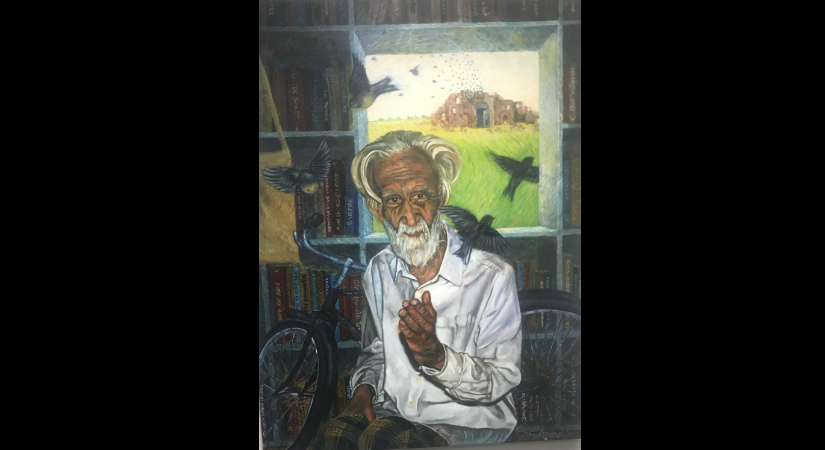Cover Story
Rootedness, rootlessness & artist Kanwal Dhaliwal’s varied tales

Village landscapes envelop the Punjab Kala Bhavan gallery in modernistic Chandigarh
By Sukant Deepak
February 29, 2024 (IANSlife) The moment you enter, a portrait of Lal Singh Dil, one of the major revolutionary Punjabi poets emerging out of the Naxalite Movement in Punjab towards the late sixties of the 20th century, stares directly at you. Village landscapes envelop the Punjab Kala Bhavan gallery in modernistic Chandigarh.
There are also portraits of Gaihal Singh Chhajjalwadi, Madam Cama, Saadat Hasan Manto, and Kartar Singh Sarabha -- the unsung ones.
In a corner, the soft-spoken major Punjabi painter, sculptor, and linguist Kanwal Dhaliwal, now based in the UK, is sitting.
As his latest exhibition, ‘Back to the Roots’, curated by Anju Bala, now travels in Punjab, he refrains from talking about the immigrant experience, highlighted in his latest work, with the cliches most immigrant artists love to use.
“The rootlessness may be for me, but for our children, what we call the ‘new’ is not alien. Thus, what emerges are newer roots, assimilation, where the outsider slowly becomes the insider,” he told IANS.
Originally from the rural Malwa region, Dhaliwal has worked in almost every medium, such as oil, watercolour, clay, wood, and stone.
Trained at the Government College of Art, Chandigarh, the latest exhibition has works from his previous series, including ‘The Village’ -- where, through drawings and sculptures, he portrays the resilience of village life, and ‘The Valiant Ones’.
“I’ve been thinking of doing an exhibition in Chandigarh for almost five years now. Whenever I would come from England, I would get along a few works with me,” he said.
Talk to him about the ‘assimilation’ of different series in one exhibition and the natural apprehension of disjointedness, and the artist asserts that while the works may be very different individually, in the context of India, all of them come together seamlessly.
“Is it not effortless to see the connections between earth, villages, and a slow life walking hand-in-hand with the mad pace of metros? This country in itself offers a certain sense of assimilation,” he opines.
And Chandigarh -- towards which artists have always had extreme views? Dhaliwal asserts that it is surprising that a foreigner (Le Corbusier) was asked to design a new city as if we were incapable of the same.
“It seems a part of Europe has been imported and set up here. The design is alien, but those who live in these houses are not, so how can complete synchronisation take place? How can an identity be carved? This place will never have a culture in the true sense of the word. People who are born here, are also not born here...”
The artist studied at the art college when it was dominated by students from the rural areas, and there was no quota for Chandigarh residents.
He feels that the ones from the countryside did not just have more depth, but also understood the real concerns of people -- a major reason many are now well established.
“Those with rural roots have a naturally instilled sense of culture, their idiom is strong, and thus their work boasts of a certain sensitivity. I am not sure if I can say the same about the ones from the urban backgrounds, who were more interested in Applied Arts.”
Looking at his portrait of Prof. Lalli, a legendary teacher of Anthropological Linguistics at Punjabi University Patiala, to whom many artists in Punjab attribute their broader world-view and sensitivity towards self and those around, Dhaliwal remembers the ‘Bhootwara’ (from ghosts) group and times, led by Lalli.
“There would be discussions the whole night. He would come to live in our ‘barsaatis’ in Chandigarh for days. Discussions never followed a linear pattern. From world literature, and theatre to architecture -- everything would be covered in one night. I went to Russia after passing out and later got a job in Himachal Pradesh, but kept meeting him, and have written a series of articles on him. I had gone to meet him in April 2014. and that is when I started this portrait. This is his last one,” he added.
All set to paint more portraits under ‘The Valiant Ones’, Dhaliwal holds around two exhibitions annually in the UK too.
"While working on the village series, so many new facets of my childhood home came alive. Perhaps that is what art does -- reintroduce a part of us to us," he added.
(This article is website exclusive and cannot be reproduced without the permission of IANSlife)
IANSlife can be contacted at ianslife@ians.in


